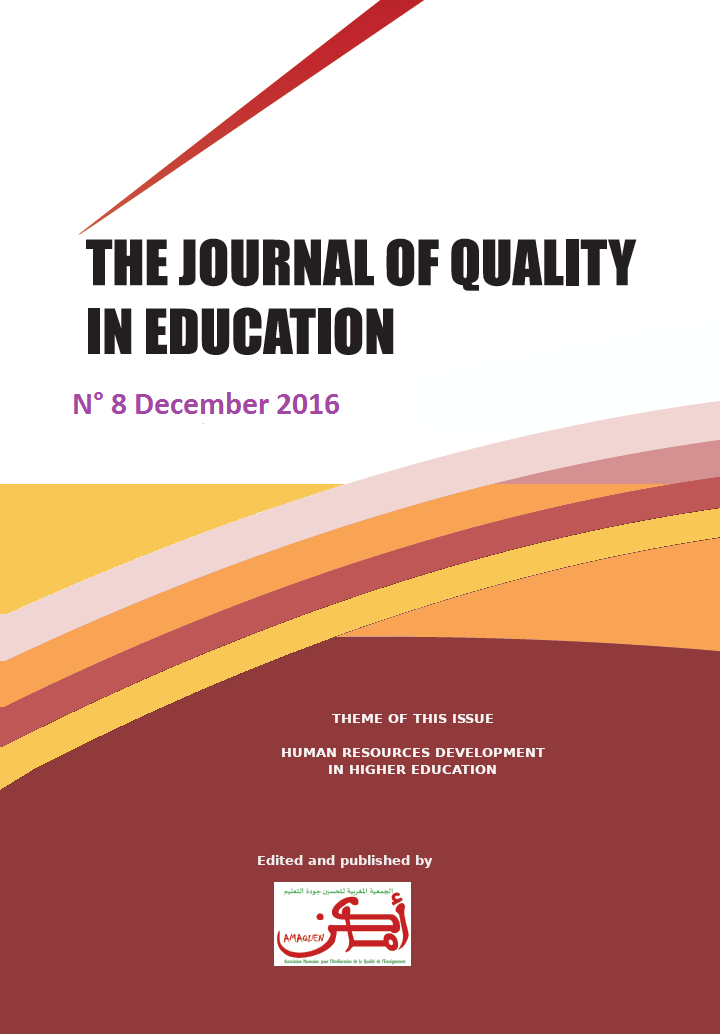Impact of simulation on the acquisition of electrical concepts The case of Moroccan high school students
Main Article Content
Abstract
Simulation is of considerable interest in electricity, because it simplifies the study of real systems, which makes learning an easy task. In this article, we discuss how to simulate the diode bridge using the PSPICE simulator. The mounting consists of two parts: a diode rectifier which allows having a pulsating current and a smoothing device which allows a direct current. The proposed simulation allows students to change the parameters of the experiment and explore the understudy phenomenon to determine the role of computer simulations in learning the electric phenomena. To measure the degree of satisfaction of users of the simulation of the Graëtzbridge, we have programmed a questionnaire to seventy students from two Moroccan high schools. The obtained results affirm that computer simulations might be used as an alternative educational tool to help students understand the electricity concepts.
Article Details

This work is licensed under a Creative Commons Attribution-NonCommercial-ShareAlike 4.0 International License.
Authors who publish with this journal agree to the following terms:
- Authors retain copyright and grant the journal right of first publication with the work simultaneously licensed under a Creative Commons Attribution License that allows others to share the work with an acknowledgement of the work's authorship and initial publication in this journal.
- Authors are able to enter into separate, additional contractual arrangements for the non-exclusive distribution of the journal's published version of the work (e.g., post it to an institutional repository or publish it in a book), with an acknowledgement of its initial publication in this journal.
- Authors are permitted and encouraged to post their work online (e.g., in institutional repositories or on their website) prior to and during the submission process, as it can lead to productive exchanges, as well as earlier and greater citation of published work.
References
L. K. Smetana et R. L. Bell, « Computer simulations to support science instruction and learning: A critical review of the literature », Int. J. Sci. Educ., vol. 34, no 9, p. 1337–1370, 2012.
Z. Zacharia, « Beliefs, attitudes, and intentions of science teachers regarding the educational use of computer simulations and inquiry-based experiments in physics », J. Res. Sci. Teach., vol. 40, no 8, p. 792–823, 2003.
Z. C. Zacharia, « The impact of interactive computer simulations on the nature and quality of postgraduate science teachers’ explanations in physics », Int. J. Sci. Educ., vol. 27, no 14, p. 1741–1767, 2005.
Z. C. Zacharia, G. Olympiou, et M. Papaevripidou, « Effects of experimenting with physical and virtual manipulatives on students’ conceptual understanding in heat and temperature », J. Res. Sci. Teach., vol. 45, no 9, p. 1021–1035, 2008.
L. Morge, « Former sur les aspects pratiques et théoriques des interactions enseignant-élèves en classe de sciences », Aster 2001 32 Didact. Form. Enseign. Rech. En Didact. Sci. À Form. Enseign. Quels Liens Quelles Interact., 2001.
B. Lehaney, H. Kogetsidis, A. Platt, et S. Clarke, « Windows-based simulation software as an aid to learning », J. Eur. Ind. Train., vol. 22, no 1, p. 12–17, 1998.
A. M. Law et W. D. Kelton, « Simulation modeling and analysis, McGraw-Hill », N. Y., 1991.
M. Chekour, M. Laafou, et R. Janati-Idrissi, « Vers l’introduction du simulateur Pspice dans l’enseignement de l’électricité: Cas du Tronc commun Sciences », EpiNet, vol. 175, 2015.
H. Doufar, Expression de scénarios pédagogiques basée sur la transposition de diagnostic de systèmes physiques. Université J. Fourier, UFR Informatique et Mathématiques Appliquées, 2002.
S. M. Alessi et S. R. Trollip, Computer-based instruction: Methods and development. USA: Prentice Hall Professional Technical Reference, 1991.
R. T. Strauss et M. B. Kinzie, « Student achievement & attitudes in a pilot study comparing an interactive videodisc simulation to conventional dissection », Am. Biol. Teach., vol. 56, no 7, p. 398–402, 1994.
D. Kennepohl, « Using computer simulations to supplement teaching laboratories in chemistry for distance delivery », Int. J. E-Learn. Distance Educ., vol. 16, no 2, p. 58–65, 2007.
D. Psillos, « Enseigner l’électricité élémentaire », Résultats Rech. En Didact. Phys. Au Serv. Form. Maîtres Ouvrage Coordonné Par Tiberghien Leonard Jossem Barojas-Weber Publ. Par Comm. Int. Sur L’enseignement Phys., 1998.
A. Benseghir et J. L. Closset, « De l’électrostatique à l’électrocinétique, des difficultés historiques et actuelles », Raison. En Phys. Part Sens Commun, p. 191–208, 1993.
A. Tiberghien et G. Delacôte, « MANIPULATIONS ET REPRESENTATIONS DE CIRCUITS ELECTRIQUES SIMPLES: par des enfants de 7 à 12 ans », Rev. Fr. Pédagogie, p. 32–44, 1976.
C. Szczygielski, « Lecture et compréhension dans différents systèmes sémiotiques en électricité: Raisonner sur des schémas électrocinétiques ou électrotechniques et des montages électriques », 2009.
M. Chekour, M. Laafou, et R. Janati-Idrissi, « Distance Training for Physics Teachers in Pspice Simulator », Mediterr. J. Soc. Sci., vol. 6, no 3 S1, p. 232, 2015.
G. Noupet Tatchou, « Conceptions d’élèves du secondaire sur le rôle de l’expérience en sciences-physiques: cas de quelques expériences de cours en électrocinétique », ENS, Dakar, Mémoire de Diplôme d’Etudes Approfondies en Sciences de l’E ducation, 2004.
O. Alj et N. Benjelloun, « Intégration des TIC dans l’enseignement des sciences physiques au Maroc dans le cadre du programme GENIE : difficultés et obstacles », Rev. Int. Technol. En Pédagogie Univ. RITPU, vol. 10, no 2, p. 38‑48, 2013.
M. Chekour, M. Laafou, et R. Janati‐Idrissi, « Les facteurs influençant l’acquisition des concepts en électricité. Cas des lycéens marocains », Adjectif En Ligne, 2015.
B. Richoux, C. Salvetat, et D. Beaufils, « Simulation numérique dans l’enseignement de la physique: enjeux, conditions », Bull. Union Phys., no 842, p. 497–521, 2002.
M. Droui et A. El Hajjami, « Simulations informatiques en enseignement des sciences: apports et limites », EpiNet, no 164, 2014.





